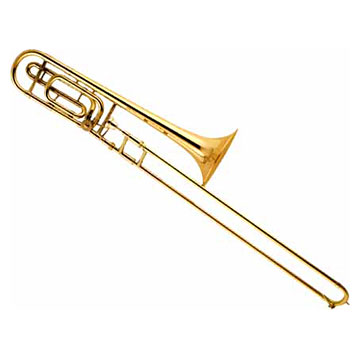Instruments of the Orchestra
Part II: Brass, Percussion, and Keyboards
This page will discuss the brass, percussion, and keyboard instruments. The brass choir includes the French horn, trumpet, trombone, and tuba, and some other instruments used less often in the orchestra, but that are common in concert or marching bands. The percussion choir uses a wide variety of instruments, particularly the timpani, but also others such as the xylophone and the snare drum. The percussion section will discuss some of the more common percussion instruments. Keyboard instruments are not always in the orchestra, but some of the more notable ones in Western music include the piano, harpsichord, organ, and celesta. Select orchestral works include the instruments, most often in the form of a concerto.
While strings and woodwinds have been a part of the orchestra since its early days, the horn, trumpet, and timpani were the only brass and percussion instruments used in classical orchestras, and the baroque orchestra hardly ever included brass or percussion. The brass and percussion sections first began to build up beginning in the early Romantic period. Today, some works may include large numbers of these instruments, or be written solely for these instruments.
For the instruments in the string and woodwind families, see the first page.
The Brass Choir
Brass instruments are also aerophones, like the woodwinds; what sets them apart is that the sound is made by the vibration of the player's lips. As a result, brass instruments, especially the French horn, are among the most difficult in the orchestra to play well. When used effectively, brass instruments can be some of the most powerful instruments in the ensemble. Pieces with a strong brass presence (such as the movement Mars from Holst's Planets Suite, or Richard Strauss's Also sprach Zarathustra) or that are exclusively brass (such as Copland's Fanfare for the Common Man, using only brass and percussion) can have a powerful effect on their listeners. Unlike woodwinds, which are not always made of wood, all brass instruments are actually made of brass.
French Horn

Trumpet

Trombone

Bass Trombone

Tuba

Wagner Tuba

Other Brass Instruments
Cornet

Flugelhorn

Baritone and Euphonium

Sousaphone

Percussion
Timpani

Miscellaneous Definite-Pitch Instruments
An instrument of "definite pitch" is an instrument where you have different notes that ring out at precise intervals. The timpani is an example of this, as are all the string, wind, and keyboard instruments in the orchestra. Most of the definite-pitch percussion fall under the category of "mallet percussion," which are instruments that can play many different notes, including multiple notes at once. These instruments are in the xylophone family (like marimbas and glockenspiels) or are types of chimes (like the tubular bells). Here are some percussion instruments (besides the timpani) of definite pitch:
Xylophone

Marimba

Glockenspiel

Tubular Bells

Vibraphone

Miscellaneous Indefinite-Pitch Instruments
Instruments with indefinite pitch do not produce precise notes, and are limited to the percussion family of instruments. Instead of playing melodies like mallet percussion, these are used for rhythmic effects. Here are some of the more common indefinite-pitch instruments:
Bass Drum

Cymbals

Snare Drum

Triangle

Tambourine

Tam-Tam

Castanets

Whip

Ratchet

Keyboard Instruments
Keyboard instruments actually make their sounds using many different methods; pianos hammer strings, harpsichords pluck them, and organs don't use strings at all (their sound is made from pipes). Some modern keyboard instruments even make sound completely electronically. However, the way the player sets in motion the mechanism that produces the notes is similar on all of them; they press down one or more keys or pedals with their hands and/or feet. The piano is the quintessential keyboard instrument, and usually a musician learns it first before moving on to other keyboard instruments, such as the organ.
In the orchestra, someone who plays piano or another keyboard instrument can either be a member of the percussion section, or an extra musician specifically hired to play keyboards. When a concerto is being performed, the musician is usually a soloist who specializes only in that instrument. Here are some of the more common keyboard instruments used in orchestral music:
Piano

A Steinway grand piano.
Organ

A Baroque-era pipe organ from a church in Copenhagen, Denmark.
Harpischord

A Flemish-style harpsichord.
Celesta

Other Keyboard Instruments
------------------------------------------------------
Back to the first page
Comments (0)
You don't have permission to comment on this page.